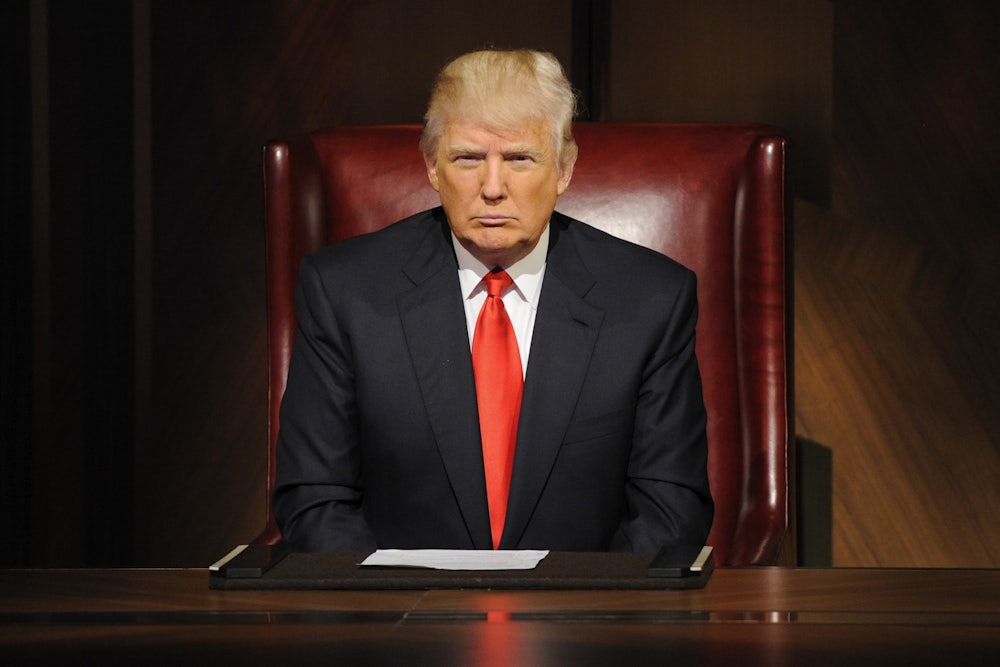If there’s any key to Donald Trump’s electoral appeal, other than his sheer entertainment value, it’s his pledge to be the biggest jobs president of all time. “I am going to bring your jobs back to America,” he promised a Michigan crowd last October. “A Trump administration will stop the jobs from leaving America,” he assured an audience in Florida the day before the election. “I will be the greatest jobs producer that God ever created,” he boasted just before he was sworn in. All told, Trump has vowed to create an additional 25 million jobs within a decade.
Since taking office, however, Trump has done nothing concrete to put more Americans to work, beyond the deal he struck with air-conditioning giant Carrier to keep some 800 jobs from being outsourced to Mexico. Instead, he has moved in the exact opposite direction. On his third day in office, Trump instituted a hiring freeze across the federal government. And in April, declaring that there are “too many federal employees,” Trump’s budget director, Mick Mulvaney, told agency heads to “begin taking immediate actions” to reduce the government’s workforce dramatically. So far, God’s greatest jobs producer is starting out his term by destroying them.
It’s more than a little dissonant to hear a president who paid such lip service to job creation kick off his administration by calling for people to be fired. But Trump’s attack on the federal workforce makes complete sense, given the overarching political goal laid out by his strategist Steve Bannon: the “deconstruction of the administrative state.” What’s more, the workers who will be most affected by Trump’s staffing cuts are women and minorities—constituencies that make up the base of the Democratic Party. Trump, in essence, doesn’t see public-sector jobs as real jobs. If they’re not held by white, blue-collar men in hard hats, working on factory floors or construction sites, they don’t appear to count.
Trump’s hiring freeze was intended to reduce the size of the federal workforce through attrition, and that’s just what it has done. Since January, according to the Bureau of Labor Statistics, the federal government has shed more than 8,400 jobs, in many cases due directly to the freeze. And while Trump lifted the freeze in April, federal agencies are now preparing to start firing employees and developing a long-term plan to slash the size of the federal government. “We think we could run the government more efficiently than the previous administration, and with fewer people,” Mulvaney says. “This is a big part of draining the swamp.”
The upcoming cuts will disproportionately hurt women and minorities, who have benefited from the government’s commitment to fair practices in hiring and promotions. Roughly one in five black workers in America are currently employed by the government; they’re 30 percent more likely than whites to hold such jobs. Women make up 60 percent of public-sector jobs, and black women make up more than 20 percent of the public-sector workforce, compared to less than 13 percent for white men. They also end up feeling the sharpest effects of layoffs: During the Great Recession, black workers, and especially black women, lost government jobs at a disproportionate rate.

Trump’s supporters, who are overwhelmingly white and male, are far more likely to hold jobs in the private sector. Manufacturing, one of his favorite industries, is nearly three-quarters male and 10 percent black. Construction is more than 90 percent male and less than 6 percent black. For Trump, it appears, these are the only jobs worth saving.
But even workers who wear hats that read MAKE AMERICA GREAT AGAIN stand to lose out under Trump’s plan to slash the federal government. As studies have repeatedly shown, fewer public servants means less consumer spending and lower tax revenues, which hurts the entire economy. Employing fewer teachers has been found to reduce children’s future wages by billions of dollars. And gutting the federal workforce dampens job growth elsewhere: Between 2009 and 2012, one report shows, the failure to hire more government workers cost Americans some 500,000 jobs in the private sector.
It was never feasible that Trump would follow through on his pledge to resurrect American jobs all on his own. One-off deals like the one he struck with Carrier do nothing to alter the underlying forces of the U.S. economy. But Trump can single-handedly decimate employment among federal workers. Women and people of color who have found steady, middle-class jobs working for the American people are about to be handed a pink slip by the biggest jobs president of all time.
